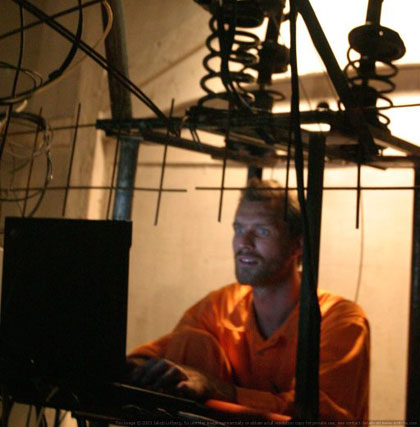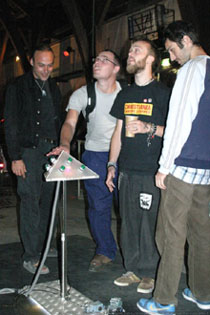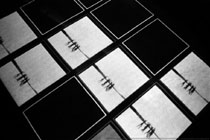|
[July 13th 2004] 
A man and his machine: Simon Moe. From Halfmachine 2003. Photo from www.halfmachine.org.
Halfmachine 2004. Interview with Simon Moe
The theme of the Halfmachine event is described as inspired by the 'meltage of man and machine'. In August 2003 some 200 people partook in a massive collaborative event in the Grey Hall (Graa Hal) at Christiania in Copenhagen. The event focused on the repurposing of discarded machinery, interactivity, and the artistic use of technology, both digital and mechanic. Inspired by Robodock and Burning Man, a constellation of tech heads, artists, performers, musicians etc. joined forces in this truly collaborative event.
This year they are back. Thomas Petersen asked Simon Moe - one of the artists and builders of the event - a few questions about Halfmachine and about working with technology from a performative and artistic point of view. Currently Simon is working on the installation Regntid (Rain Time) as a part of Halfmachine. Simon is also a part of the tabla.dk group, that deals with digital art and interactive installations. Photos from www.halfmachine.org.
Halfmachine 2004
The Grey Hall (Graa Hal)
Christiania, Copenhagen
August 4-8, 2004 (note the change of date).
Opening hours: 4 pm - 12 am (16-24).
www.halfmachine.org
info@halfmachine.org
Contact Simon Moe at simon@tabla.dk. Helping hands for building Halfmachine can use the same email address or call him at (+45) 50905929.
First of all, tell me a bit about Halfmachine. What is the general idea behind the event?
Halfmachine is a festival for interactive and digital art based on three principles or themes. First of all, the relation between human and machine. The function of machines in our everyday lives tends to become more and more ubiquitous, meaning that it is so integrated and constantly encountered that it is difficult to observe and participate in the relation as such. As human beings we would rather use the machine for whatever purpose it may have in a specific context than put ourselves in a position where we can discuss and debate its implications from a researchist or anthropological point of view. The most important purpose of events such as Halfmachine is to bring forth and support this perspective. Secondly the festival is a work-in-progress exhibition. There are 10 days where artists build, discuss, and recreate art pieces or mechanical devices and only three days of exhibition. The main goal is thus not only to exhibit but as much to shape and transform the network between artists and machine developers. Thirdly the festival is based on principles of 'repurposing' and 'bricolage'. Repurposing, which is a computer programming term, means to take something from one context and reformulate it in another. Thus Halfmachine development reveals object functions that are usually present in a well known context and uses them alternatively in performance and installation. 'Bricolage' is a French word for transforming scrapheaps into usable or aesthetic objects. The third goal in Halfmachine is to transform mass produced digital and mechanical machines and put them together in new ways, suggest alternative functions.
 
A truly collaborative effort. From Halfmachine 2003. Photos from www.halfmachine.org.
As I understand it, the process of building the event is organized in a rather unique way. Tell me about the way this process is organized and the intentions behind.
Halfmachine is a non-profit event. There are no real administrative organs or decision makers. The decision and power process and general organisation take shape only when serious people spend voluntary time in making it happen. No need to mention the pitfalls in this type of organisation are countless. There is a risk that the final exhibition becomes imprecise and chaotic - or even doesn't become at all. The benefit is that the festival works more as a network than an institution. And this is necessary from the perspective that we - the people engaged in machine development and art for example - do not represent one institution and probably wouldn't and couldn't. The pieces that are developed in the Halfmachine context have to reflect the fact that people don't come to Halfmachine out of need or external demands. They come to explore and reflect upon exactly what interests them in their field of work and to combine this knowledge with the ideas and competences of people with very different perspectives. This process is hard if not impossible to control from other perspectives than from inside.
 
From The Human Robot project by Pipaluk Supernova and Thomas Joergensen. Halfmachine 2003. Photos from www.halfmachine.org.
When researching the human relationship with machines, what makes the frameworks of art, performance etc. especially useful compared to a scientific approach?
This is a big question, but I can try to give a short general answer. Both scientific and artistic approaches to machines may be useful. The frameworks of art and performance present settings where objects are perceived of differently than in everyday life or scientific practices. Especially in performance theatre and -dance it is conventional to interpret and use objects and space in line with people, or even to swap roles between actor and object-human as sculpture or texture, object as actor or interpreter. In a performative setting you can't evaluate objects (like machines) in terms of their predefined 'function', which means that you get a chance to see the relationship between human and machine working in time and space as a whole entity. This gesture is revealing because it sets free for a moment, the boundaries of the practicality of every day life, and gives us a chance to experience all the rest. The concept 'scientific' usually refers to a set of actions that are somehow connected progressively to obtain some predefined goal. The concept of performance doesn't involve progress in the sense that something gets better or worse over time. This standpoint is very hard to take in everyday actions, whether they are scientific or not. You can say that our everyday urge to know and understand how things 'work' prevent us from seeing what these things 'are', and how we relate to them. This is why the people who love computers the most are the ones who get the worst physical injuries from sitting in front of them all the time. They forget (or even deny) to see the relationship as a whole and focus on single functions. The performance and art frameworks present us with a different view of machines than scientific or everyday life approaches. The difference is equivalent to the difference between reading poetry or 'just' reading text. If you read a poem with the presupposition that all words are shaped like sentences that together forms and understandable whole you don't get much out of it. Reading a poem means accepting that the words shapes figures or music or inner pictures that are not logically or rationally connected. This doesn't mean that reading poems is a useless activity however, or that it doen't teach us anything about words. They present us with a setting where we connect to and experience our relationship with words as such, instead of using them for practical purposes for example.
 
Left: Foot sensors from the Moving Pictures
installation by Nicolas Padfield, Ninette Jensen and
Heidi Engsig. Right: Tina Tarpgaard
and Pelle Skovmand: Horizontal Vertigo,
a dance performance based on video delay. Both projects from Halfmachine
2003. Photos from www.halfmachine.org.
Halfmachine represents one of the few major approaches in the field of technological art in Denmark. In your opinion, what is needed to strengthen this field?
Copenhagen has a very vivid environment of artists, musicians, creative developers, techno nerds etc. So the missing factor is not the amount of people. Nor is it money or time. We should have lots of both. It is extremely easy to get sponsoring and work together with various companies in Denmark. The thing that is missing in this city must be square meters. It is not a coincidence that Halfmachine takes place in Christiania. It is one of the incredibly few places where there are workshops and helpful people that don't mind if you make a little noise. The harbour could be developed in a direction that includes such options. The education institutions and cultural/technological ministries could provide facilities. The city could develop in a direction where all free space of relatively large dimensions is not immediately sold out to corporations or apartments.
|